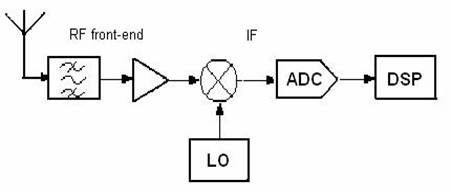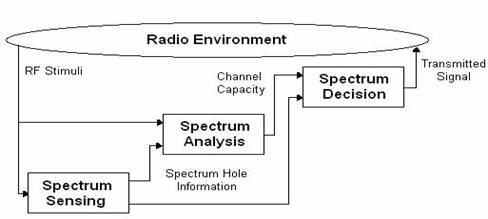Abstract
The goal of achieving interoperability between various military forces has been a strong driver behind the development of software defined radio technology. Architectures of software defined radio systems can be dynamically reconfigured based on mission requirements, providing software control of a variety of modulation techniques, wide-band or narrow-band operation, communications security functions and waveform requirements of current and evolving standards over a broad frequency range. This paper will present a short overview of Software Defined Radio (SDR) and Cognitive Radio (CR), two new technologies used today in military radio communications systems. I. Introduction Interoperability problems are an obstacle in joint operations, where each nation typically has its own radio systems. Recently, emphasis on peacekeeping, disaster relief, homeland security and other non-combat military operations has created further problems. In these sense, military units must communicate with public safety agencies, humanitarian organizations, and the civilian population [4]. Software Defined Radio (SDR) and Cognitive Radio (CR) are advanced radio technologies that promise to resolve interoperability challenges and forever change the face of modern military communications. The digital battlespace of the future is based on a flexible communication platform that connects separate systems together [5]. Software radio technology provides advanced signal processing and multi-band multi-mode software-based RF receiver capabilities which can decrease the amount of radio equipment needed and enable efficient communication between different militay units at the operational area. II. Software Defined Radio Software defined radio (SDR), as many others new technologies, has been initiated by the military in an attempt to overcome numerous problems associated with traditional radio systems. By implementing functions in software rather than the traditional approach of hardware, military radio systems will have a great flexibility. This characteristic offers potential solutions for interoperability and dynamic networks. The project SPEAKeasy was the real first software based radio systems in existence and the inspiration behind this project was the lack of compatibility of radio systems within the branches of the military. The SPEAKeasy began as a joint U.S. Government program to develop the architecture and technology to meet future military requirements for multimedia networking operations. It was implemented in two phases and was the first significant military investment to integrate various existing radio families into one family and demonstrated multiband, multimode radio capabilities, a specific radio system, compact and designed with commercial off-the-shelf (COTS) components, which could operate with ground force, naval, air force radios and satellites in the range of 2 MHz to 2 GHz. Its performance in multi-path environments would be excellent [2]. Furthermore, it would improve on the antijamming and interference rejection capabilities of conventional radio systems. The first phase of the project (1992-1995) produced a radio complemented with a Sun workstation for user interface. The radio consisted of modules that could be plugged into a VME bus during operation. The wide operating range of 2 MHz to 2 GHz couldn't be accommodated by a single RF front end with the available technology. Thus it was divided into three bands, 2 MHz to 30 MHz, 30 MHz to 400 MHz, and 400 MHz to 2 GHz, and a low-IF RF front end was designed for each. The digital signal processing was done on a quad TMS320C40 16-bit DSP embedded module.The final product demonstrated in 1994 only operated in the 30 MHz to 400 MHz band, but met most of its other functional requirements. Modules for wideband modulation schemes such as frequency hopping spread spectrum, and narrowband schemes such as single sideband AM, were demonstrated successfully. The second phase of the SPEAKeasy project (1995-1999) produced a system based on a PCI bus interface. User interface is provided through a PDA type device. The signal processing was done using a combination of DSPs, and for the first time in radio systems, FPGAs. A separate microprocessor was used for data security. The RF front end was based on a low-IF architecture, and accommodated the 4 MHz to 400 MHz frequency range. The main drawback to this system was that it only handled narrowband modulation schemes. As the descendant of the SPEAKeasy project, the Joint Tactical Radio System was established as a program by the U.S. Department of Defense in 1999 in order to achieve software programmability in radio technology, enabling the support of multiple protocols and frequency bands for military communications. It is an evolving standard adopted to make all radio systems within the US military interoperable. At the technical core of the JTRS program is the Software Communications Architecture (SCA). The SCA, an open architecture, describes the framework that is used to establish, maintain, and tear down waveforms in a radio system. The SCA's goal is to support waveform management while at the same time support waveform portability and component reuse, where these goals are achieved through an Operating Environment (OE). The OE combines the set of Core Framework services, interfaces, board support packages, operating system, and middleware services to host an SCA application [3]. The fundamental idea in SDR is to replace as much as possible of traditional radio hardware (ASIC) associated with a particular type of modulation, coding or frequency range, with more general digital circuits, DSPs or FPGAs. In this way, it becomes possible to use the same radio hardware for many different types of radio communication by simply reprogramming it. An ideal software radio (Figure 1) would consist of a RF front-end, one ADC and a DSP (Digital Signal Processor). This simple architecture moves the analog/digital (hardware/software) boundary as close as possible to the antenna. If the input RF signal is in the range of several hundred MHz, the requirements on the ADC and DSP are very high. Current A/D converters and processors cannot meet the requirements imposed by a direct implementation of this architecture. One step towards the ideal software radio is reachable though, Figure 2. A wide band mixer and a local oscillator is used to downconvert the whole RF signal band to IF. The IF signal is usually a band pass signal above the base band. After that a wideband ADC converts the analog IF signal to a digital signal which is separated into different channels in software. The rest of the signal processing is then done in software in a DSP or FPGA. III. Cognitive Radio The NeXt Generation (xG) Communications program of DARPA aims to implement the policy based intelligent radios known as cognitive radio (CR). The program goals are to develop both the enabling technologies and system concepts to dynamically redistribute allocated spectrum along with novel waveforms in order to provide dramatic improvements in assured military communications in support of a full range of worldwide deployments. Cognitive radios assess available spectrum in their operating environment and jump in and out of spectrum bandwidths and enables real time interaction with its environment to determine appropriate communication parameters to adapt to the dynamic radio environment, anywhere on earth. A generic architecture of CR is essentially similar to existing SDR. The new characteristics of cognitive radio are: the wideband sensing capability of the RF front-end and the reconfiguration of each component via a control bus to adapt to the time-varying RF environment. The tasks required for adaptive operation in open spectrum are shown in Figure 3 which is referred to as the cognitive cycle. The cognitive process starts with the passive sensing of RF stimuli and culminates with action (transmited signal). Spectrum sensing, spectrum analysis, and spectrum decision are the main steps of the cognitive cycle. In spectrum sensing phase CR monitors the available spectrum bands, captures their information, and then detects the spectrum holes. The characteristics of the spectrum holes are estimated in spectrum analysis process. In the spectrum decision it determines the data rate, the transmission mode, and the bandwidth of the transmission. Then, the appropriate spectrum band is chosen according to the spectrum characteristics and user requirements. Once the operating spectrum band is determined, the communication can be performed over this spectrum band. Since the radio environment changes over time and space, the cognitive radio should keep track of the changes of the radio environment. If the current spectrum band in use becomes unavailable, the spectrum mobility function is performed [1]. IV. ConclusionsFuture militay radio systems need extremely fast and flexible architectures to support varying standards, algorithms and protocols with very high data rates. Software Defined Radios and Cognitive Radio based on DSP-FPGAs are a widely proposed solution for these systems. The key benefit of SDR technology to military communication system is interoperability across disparate radio networks, frequency bands, and technologies. Although the potential benefits to interoperability are paramount, SDR and CR technologies could also impact other areas such as spectrum management and security. References[1] Akyildiz I., Lee W., Vuran M., Mohanty S., "NeXt Generation/Dynamic Spectrum Access/Cognitive Radio Wireless Networks: A Survey,'' Computer Networks Journal, Elsevier, 2006 [2] Fraidun Akhi "Design and Implementation of a Software Radio Testset for Research and Laboratory Instruction", Master thesis, Auburn University, 2003 [3] Robert M., "First Open-Source C++ Implementation of the SCA Released by MPRG, Mobile and Portable Radio Research Group , Virginia Tech, 2004 [4] Steinheider J.," Software-defined Radio Comes of Age", RFdesign Magazine, 2003 [5] Tuukkanen T., Pouttu A., Leppänen P., "Finnish Software Radio Programme", Telecommunication Laboratory/Centre for Wireless Communications (eds.) |
© ZMNE BJKMK 2006.



